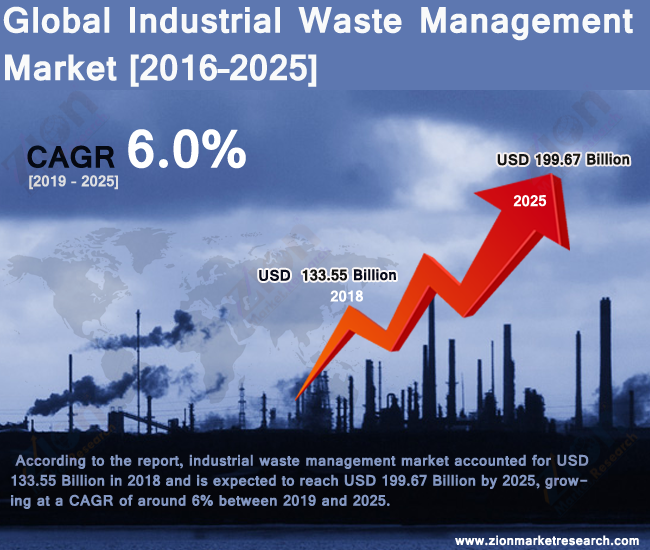The report claims that the industrial waste management market would increase from its 2018 total of USD 133.55 Billion to USD 199.67 Billion by 2025, representing a CAGR of almost 6%.
The word “industrial waste” is used to describe any undesired by products from industrial processes, such as mining or manufacturing. Interest in conversion technologies, from the more conventional mass-burn and landfill gas-to-energy to the more outlandish gasification, plasma arc gasification, hydrolysis, and pyrolysis, has increased in response to the growing cost of oil and the rising cost of landfill disposal.
Many different kinds of industrial processes can lead to some really severe hurdles when it comes to the proper handling, collecting, and disposal of waste products. Compliance with safety laws and environmental protection are of the utmost importance since the waste may have hazardous qualities and/or properties that are destructive to the environment. Neither state nor federal governments have jurisdiction over industrial waste management. The solid wastes must be managed by the enterprises that generate them. Numerous techniques and strategies are used for the control of industrial waste.
Growth Drivers
One of the primary reasons that is likely to fuel the growth of the industrial waste management market in the predicted timeline is the increasing attention on energy and resource recovery around the globe. The declining reserves of non-renewable elements like phosphorus, copper, and zinc emphasize the need for more investments in resource recovery and reuse across the food, waste, and sanitation sectors, despite the fact that global demand projections for water, food, and energy predict continuous and significant growth. Resource recovery enables extracting value even from seemingly discarded resources, in addition to reducing food waste along the food chain.
The need for waste management solutions of all kinds has increased dramatically in recent years, especially in nations with high per capita income. All around the world, the pace of urbanization and industrialisation is quickening at an unprecedented rate. More and more companies are realizing the significance of appropriate waste management in tandem with the rapid development of recycling equipment technology.
Growing numbers of companies in sectors including aerospace and military, transportation, electronics, energy, the food and beverage industry, and biotechnology are all factors in the development of new industrial sectors. Globally, the number of industries is expanding at the same rate as the amount of scrap metal and other commodities they produce. A growing volume of trash has raised serious concerns among citizens and leaders in many nations. As a result, there is a growing need for efficient waste management in all parts of the world. So, during the predicted time period, there will be a greater requirement for industrial waste management.
An adequate management system must be put in place to handle the challenging-to-dispose-of scrap. The consumer now has more disposable income, leading to the earlier discard of otherwise usable products and a rise in total wastage. As sectors like manufacturing, pharmaceuticals, and healthcare produce more hazardous waste, there is a corresponding rise in the demand for waste management services.
Segmentation Analysis
The machinery & equipment sector, the food & pharmaceuticals sector, the metallic minerals sector, the electronic sector, the plastic & chemicals sector, the textile sector, and others make up the end-user segment of the industrial waste management market. Gold, silver, copper, platinum, and palladium can all be found in discarded electronic devices, as can iron, aluminum, and recyclable plastics. Companies that offer recycling and marketing solutions for electronic garbage (e-waste) have seen an influx of millions of dollars over the past year from both households and businesses. Companies in the textile industry are also looking for ways to cut down on waste because of rising resource prices, tougher waste control and disposal legislation, and increased disposal expenses.
Due to industrial inefficiencies, the food and drug business annually loses $50 billion. Producing processed foods at a lower price and with less of an environmental impact is possible with better waste management. Wastes from mineral processing are those leftover after ores and minerals have been mined and processed. Although many mines are in out-of-the-way places, mineral processing wastes are a common occurrence everywhere. Historically, the mining industry has made use of its own waste products, either by reprocessing to recover more minerals or through other means.
Regional Analysis:
North America, Europe, Asia-Pacific, the Middle East and Africa, and Latin America are the five key regions identified in a study of the global industrial waste management market. These areas have all been analyzed independently. The Asia-Pacific region is projected to be the study’s largest market segment. In 2020, the entire economy was valued about $325 billion. There are a lot more people living in the Asia-Pacific region compared to the rest of the world. As a result of the region’s burgeoning economy, an increasing amount of surplus trash is being produced. China, a neighboring country, produces a lot of garbage, and the government there is doing a lot to clean up the environment. Because of the growing volume of trash in the area, industrial waste management services are in high demand.
The global Industrial Waste Management market is segmented as follows:
Global Industrial Waste Management Market: Service Segment Analysis
- Collection
- Recycling
- Landfill
- Incineration
Global Industrial Waste Management Market: Type Segment Analysis
- Non-Hazardous
- Hazardous
Global Industrial Waste Management Market: By Waste Type Analysis,
- Construction and Demolition Waste
- Manufacturing Waste
- Agriculture Waste
- Chemical Waste
- Mining Waste
- Oil & Gas Waste
- Nuclear Waste
- Others
Global Industrial Waste Management Market: End-User Segment Analysis
- Machinery & Equipment
- Food & Drug
- Metallic Minerals
- Electronics
- Plastic & Chemicals
- Textile
- Others
